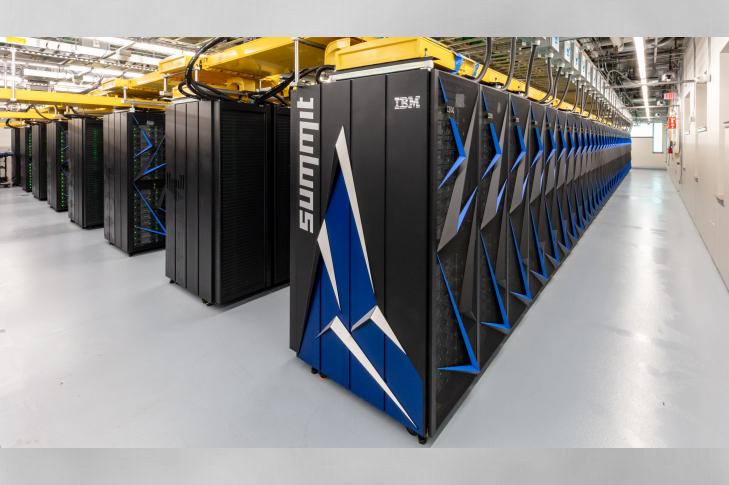The Oak Ridge National Laboratory launched the world's fastest supercomputer Summit

Summit supercomputer node. Photo: Oak Ridge National Laboratory (USA).
Most likely, the United States will regain leadership in the TOP500 supercomputer rating. On June 8, 2018, the launch of the “most powerful in the world” Summit supercomputerwith a capacity of 200 petaflops. And if China does not present any surprises, then in the June TOP500 there will be a change of leader . The claimed 200+ petaflops are more than enough to outrun the current Linpack champion Sunway TaihuLight (93 PFLOPS) in the Linpack test.

The Summit supercomputer weighs 340 tons and occupies a room of 860 m². On cooling 15 tons of water a minute are pumped over. Photo: Oak Ridge National Laboratory
The Summit supercomputer consists of 4608 nodes, each of which has two IBM Power9 22-core processors and six Nvidia Tesla V100 graphics processors. Nodes are connected by a Mellanox dual-rail EDR InfiniBand network with a throughput of 200 Gbit / s per server. For IBM, this is a presentation of the AC922 Power9-GPU servers that can be offered to other customers.
With full hardware, all GPUs alone provide peak performance of 215 petaflops with double precision. In addition, each V100 yields another 125 teraflops with mixed accuracy — this is the main type of operation of the tensor V100 core. Thus, in deep learning applications, peak performance can be on the order of 125 × 27648 = 3.46 exaflops . If realistically, then around 3.3 exaflops, experts say.
This is not just theoretical calculations. According to the director of the Oak Ridge National Laboratory, Thomas Zacharia (Thomas Zacharia), even before the system was completed, researchers launched computation of genomes on tensor GPU cores- and recorded a performance of 1.88 exaflops. The application processed genomes in search of samples that meet specific conditions. This is the first time in the history of computer technology when the de facto barrier of 1 exaflops was overcome, that is, 10 18 floating point operations per second. In the server room of this monster is such a noise that it is impossible to work there without headphones ( video ). Summit node. For the supercomputer in the room about 300 kilometers of fiber optic cable were laid. Photo: Oak Ridge National Laboratory (USA)

Of course, in addition to deep learning, Summit supports calculations in a standard set of applications that are of interest to the US Department of Energy, including calculations related to thermonuclear energy, alternative energy, materials science, climate modeling, computational chemistry and cosmology. At the same time, Summit remains an open system, so that customers will run on it all kinds of calculations that they want, even completely unrelated to energy. Summit is expected to be used for health applications in areas such as the search for new drugs. As Thomas Zachariah said at the press conference, their research center should be something like CERN for medical data mining and analytics.

Supercomputer Summit. Photo: Oak Ridge National Laboratory
When in 2014 a contract was signed with IBM to build this supercomputer, it included a GPU. At the time, the Department of Energy had very vague ideas about what to do with deep learning opportunities, but Nvidia decided to implement tensor cores in the V100 - and as a result, Summit suddenly turned into a monster of AI applications. So it can be assumed that the system will be loaded with many advanced AI studies, in addition to its main responsibilities. So far, projects for Summit are selected by request, but in 2019 the system will become more widely available through the Innovative and Novel Computational Impact on Theory and Experiment (INCITE) program.

Multicore microprocessor Chinese supercomputer Sunway TaihuLight. Until June 8, 2018, this supercomputer was considered the most powerful in the world.
After the launch of Summit, the authorities will probably decide on the decommissioning of its predecessor, the Titan supercomputer, which at the time of its launch in 2012 was recognized as the most powerful in the world and is still the fastest supercomputer in the United States. But now supporting his work makes little sense, because he is 8 times lower in speed than Summit, while inferior in energy efficiency 5 times.
Titan has K20X graphics processors, in which the performance of single-precision computing for machine learning is limited to a modest four teraflops per device. Moreover, all programs for Titan are easy to transfer to Summit.
